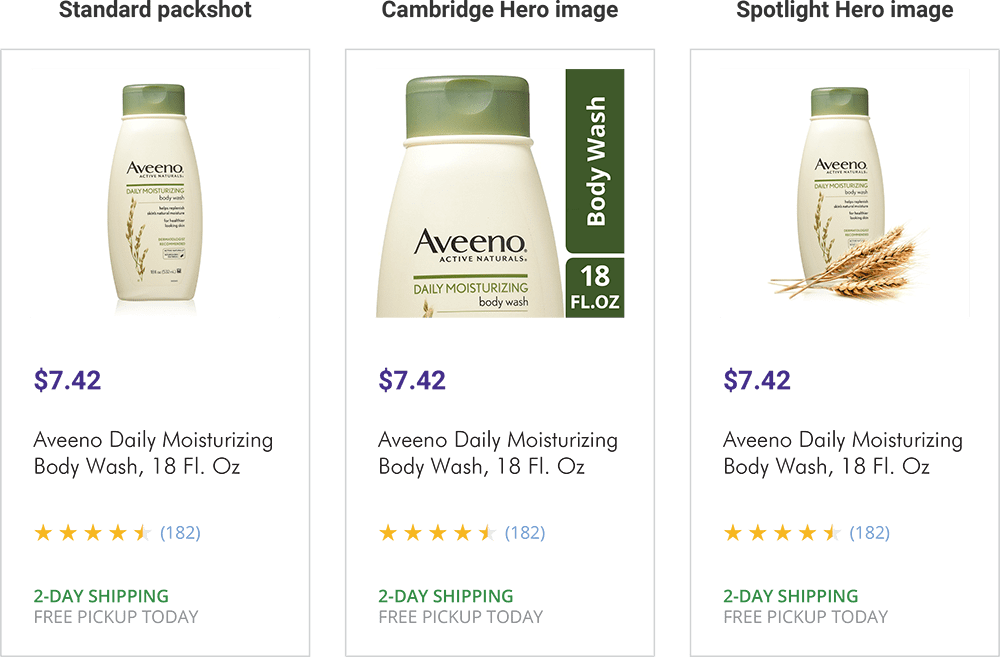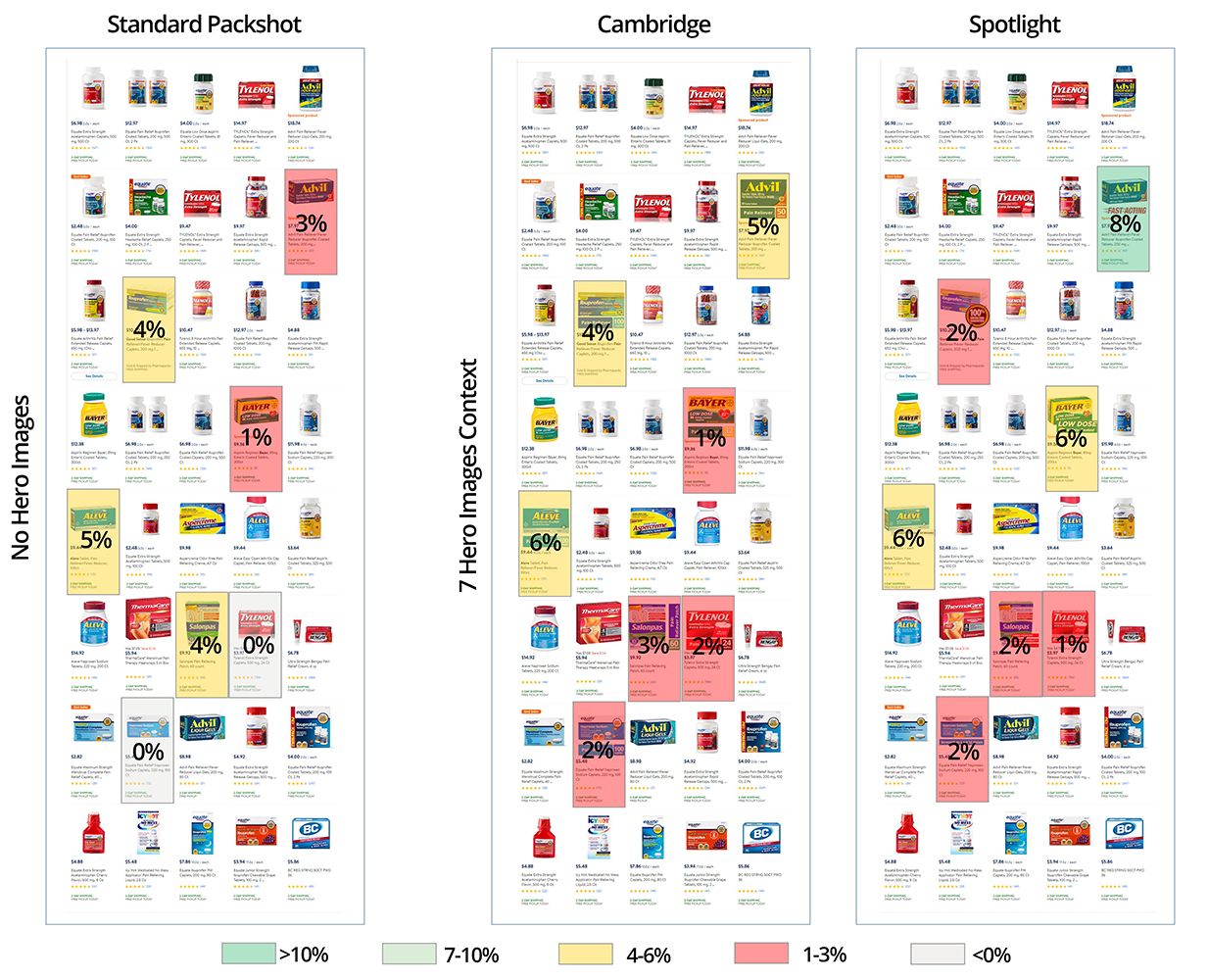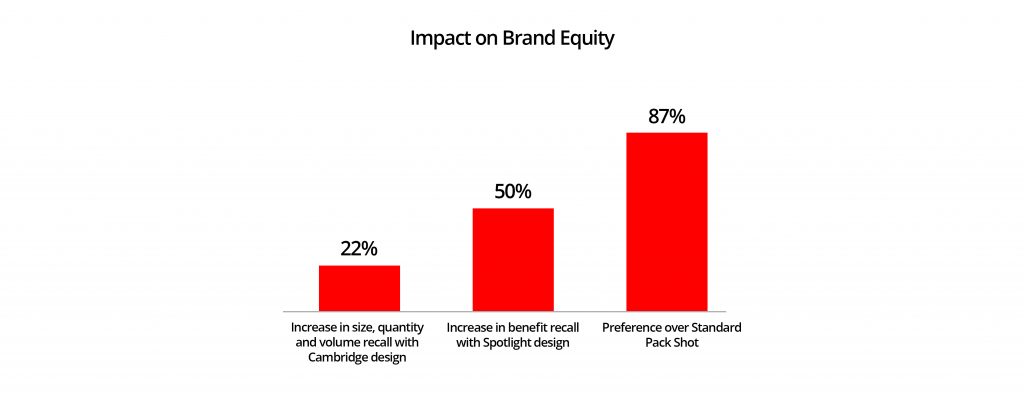When it comes to optimizing packaging designs, online channels provide much more freedom to CPG companies than traditional retailers. This wave has been started by Unilever and the University of Cambridge, who developed Hero Images – e-commerce product photos especially tailored to provide a clear and readable alternative to conventional pack shots. This product image optimization is designed to enhance the online shopper’s journey and help them to recognize four key elements (brand, variant, format, and size). That way, the risk of buying the wrong product is minimized, while online sales conversion can be significantly increased.
The EyeSee team developed an alternative to Unilever & Cambridge solution – Spotlight Hero Image, which highlights the products most distinct feature, i.e. variant.
To understand the importance of this emerging practice in online product visualization, EyeSee conducted an online packaging study. The primary objectives of the study are:
• Are hero images better than standard package images for online purposes?
• Which type of hero image is better – Cambridge or Spotlight?
Study design
Three types of package designs were tested – Standard Package Design, Cambridge Hero Design, and Spotlight Hero Design – across six categories: cereals, dog treats, body wash, dish care, toilet paper, and pain reliever. Each respondent was exposed to all six categories, but the sample was divided into three cells, one for each type of packaging.

A total of 500 shoppers were recruited online in the USA and went through the category pages on the e-commerce website they were browsing. At the same time, they were asked to click on all products they would buy while their eye movements were tracked. After that, they filled in a questionnaire.
What we found out after testing 126 package designs over 500 people
Consumers choose online shopping because it’s fast and convenient. If packages don’t stand out and clearly communicate the product, shoppers will not click on it. Highlighting key product information so they’re visible at a glance and using a standardized visual format can significantly increase your sales.
Our tests have shown that Hero Image design performs better across most categories regarding visibility, shoppers’ interest, product type identification and purchase intent in direct preference. On the example below, we can see that both Cambridge (15% more) and Spotlight Hero Design (5% more) have shown better results in terms of visibility (in Dish Care category) than Standard Package Design. Also, Hero Images are seen on average by 15% more shoppers.

Considering this, Hero images can significantly boost sales by attracting more attention. Hero Images have 5% higher visibility than Standard Package Designs on desktop (with a greater potential on mobile, because of the smaller screen size) and can increase sales by about 15%.

By putting the right product content immediately visible, you can provide shoppers with the reassurance they need to complete the purchase; Hero Design is more purchase motivating than Standard Package Design. Cambridge Hero Design has a 35% bigger purchase intent than Standard while Spotlight Hero Image has 20% higher purchase intent in the Pain Reliever category.

Hero images can impact brand equity as well
Hero Image Design increases important information (size, quantity, and volume) identification by up to 50%; almost 5 times more recalled with Cambridge Hero Design, thus shoppers are more aware of the brand. Only 10% prefer the Standard Package Design over Hero in direct preference.

Cambridge vs. Spotlight
Cambridge Hero Design provides the best quantity and size identification at first glance – important information is easily noticed and memorized across all tested categories after the short exposure; on the other hand, Spotlight Hero design is chosen for being appealing and showing the product and its benefits more closely.
Unlike Spotlight Hero Images, Cambridge Hero Images affect inferior positioned products. Again, intuition is insufficient to predict this kind of stimuli behavior, so testing is essential: obviously, tested hero images have an advantage.
On the other hand, Spotlight Hero Images are liked more and in 4 out of 6 categories chosen as most purchase inviting. In this case as well, intuitively created images are expected to be liked but this kind of preference is insufficient to predict purchase decision.
By keeping the above points in mind and experimenting with new packs shots design, you can ensure impact and competitive advantage. Our study has shown that if a hero image is perceived as a whole, it might facilitate brand recognition: emphasized feature attracts attention to the brand. Understanding what type of package you need and combining it with right messaging is key to maximizing the effect on shoppers, and effectively brand recognition.